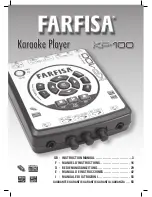
Recording a piano
The stereo recording of an acoustic piano exemplifies the sonic quality and overall beauty of the
instrument. Basically, a stereo pair of microphones is used for recording a piano performance.
C onnect the left microphone to IN1 and the right one to IN2. We recommend you to create one
track in the DAW software and set it to stereo.
In most cases, a grand piano is recorded with its lid open.
There are several ways to effectively record the piano, but here we will focus on recording the
piano from a short distance. By opening the lid and placing a microphone outside of the piano, you
can record the entire sound of the piano including sounds reflected by the lid. On the right from
the player's side (open side of the lid), place the left and right microphones with a distance of 20
cm or around between them. Leave a space of 20 cm or around from the edge of the piano. By
placing the microphone at half the height of the lid, the microphone can pick up sounds including
reflected ones well. Due to the structure of the piano, the left microphone picks up a large portion
of high-pitched tones.
Set the input levels while the piano is being played, and start recording. C heck the recording to
determine if the mic positions need adjusted – for a more pronounced attack, move the
microphones closer. For more of a room sound, move the microphones further away. To enhance
the stereo effect and increase the width, increase the distance between the two microphones.
Additional mics can be used in combination with the TM-80
mics for on-mic recording of the piano. Two more mics placed under the lid and closer to the
strings is used for a clearer sound. Also, placing mics under the piano and close to the sound
board is used for yet another quality of the piano’s sound.






















